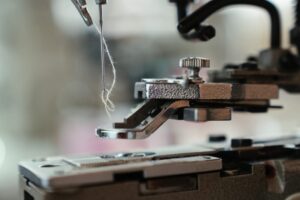During sewing, the garments, sewing thread drawn-off hamper deeply to the garments production and quality of garments. Normally, sewing threads in the needle move at a speed from 140-160km per hour during the running of sewing machines. It can reduce the strength of sewing thread 2 to 32% due to the friction between the threads and different parts of the sewing machine. For this reason, sewing thread inspection is very important before buying the sewing thread from the market. As its importance in the readymade garments industry, this article has shown some key inspection matters which ensure the right quality of the thread.

Sewing Thread Inspection in Garments Industry:
Sewing threads are bought by checking for having the following properties:
(a). Thread construction or ticket number,
(b). Sew-ability of sewing thread.
Both the key inspection matters have explained the below:
Thread construction or ticket number:
In the apparel manufacturing industry, the ticket number is a commercial numbering system. Normally, the ticket number is the manufacturer’s reference number for the size of a given thread. In fact, the size or count of sewing thread is called a ticket number. The following are the tests done to identify thread construction or ticket number.
- Thread count,
- Thread elongation,
- Thread balance,
- Number of twists,
- Thread tenacity,
- Thread ply.
Sew-ability of sewing thread:
The ability of sewing a thread is called sew-ability. To identify the sew-ability, 3 thread packages are collected from a lot and sewn 100 yards length, and here also noted the running performance of the sewing machine. It is done to determine the ability of sewing thread compared with the fault-free thread. Also, the following properties are inspected to determine the sew-ability of the thread:
- Imperfections of thread,
- Finishing of thread,
- Thread Package density,
- Color of thread.
- Yardage of thread,
- The winding of thread.
Sew ability:
The sewing fitness of a thread is called its sewability. In order to determine the sewability, 3 packages of thread are taken from a lot, 100 yards of sewing is done and the running performance of the machine is listed. The main objective of this test is to know the capacity of flawless and beautiful sewing of each thread in a normal condition and at the highest speed of the sewing machine. During the test of sewability, the other properties of thread that should be examined are as follows:
- Imperfections: If there is any knot or slub in the thread, the thread will break frequently, causing decreasing of both the efficiency and production of the machine and the quality of the produced goods will also be deteriorated.
- Finish: The finish of thread is mainly meant to lubricant that helps thread to pass through needle eye and the various guides of machine. The amount of lubricant in threads may be from 3 to 15%. The amount of lubricant should be in the same percentage for each package of thread in a lot otherwise various problems will arise sewing.
- The color of thread: Any color of thread including white, must match with its sample and the color of the thread in the same lot should not differ considerably. Otherwise, adverse effect may result on the quality of the garments.
- The package density: Should not have any difference in density of a package or a cone from another cone. If there is difference in density, the efficiency and productivity of the machine will decrease due to frequent adjustment of the tension of the thread.
- Winding: Thread should be properly wound in the package. Otherwise thread can break frequently during sewing due to the snarling of thread after coming out of the package. As a result, both the production and the quality of goods may be damaged.
- Yardage: The length of thread in a package of thread has to be within 2% of the mentioned length (yardage) otherwise that package may be cancelled.

Ref. :
- Project report of “Effects of Different Types of Wash on Denim Fabric” by Tutul Ghosh, Junayed Hossain Chowdhury & Amit Ghose under supervision of Md. Aswad Al Haque Sarker, Lecturer, Department of Fabric Engineering, Bangladesh University of Textiles
- https://garmentsmerchandising.com
- Photo by cottonbro from Pexels


Very informative and learning opportunity on thread manufacturing. and marketing